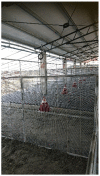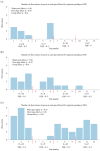Effects of Swimming Pool Conditions and Floor Types on White Roman Geese's Physical Condition Scores and Behaviors in an Indoor Rearing System
- PMID: 36496793
- PMCID: PMC9740521
- DOI: 10.3390/ani12233273
Effects of Swimming Pool Conditions and Floor Types on White Roman Geese's Physical Condition Scores and Behaviors in an Indoor Rearing System
Abstract
Biosecurity problems, including the continual risk of avian influenza spread by wild birds, have severely affected traditional free-range waterfowl production systems. Regulations and techniques for indoor goose production require more considerations for animal welfare. This study investigated the effects of swimming pool conditions and different floor types on the physical condition scores and behaviors of indoor-reared White Roman geese. A total of 48 male and 48 female White Roman geese reared from the age of 15 to 84 days were randomly allocated to pens with or without a swimming pool and with either mud or perforated plastic floors. Providing a swimming pool improved geese's eye and feather cleanliness and breast blister scores at the age of 84 days. Compared with geese reared on a mud floor, those reared on a perforated plastic floor had better feather cleanliness and higher breast blister scores at the age of 56 and 84 days. Providing a swimming pool to indoor-reared geese may reduce the proportion of abnormal behaviors, such as injurious feather pecking, by increasing water-related behaviors. This study suggests a more appropriate environment design for better balancing commercial goose production with animal welfare in an indoor rearing system.
Keywords: White Roman geese; behaviors; floor types; indoor rearing; physical condition score; swimming pool.
Conflict of interest statement
The authors declare no conflict of interest.
Figures



Similar articles
-
Effects of Different Swimming Pool Conditions and Floor Types on Growth Performance and Footpad Dermatitis in Indoor-Reared White Roman Geese.Animals (Basel). 2021 Jun 7;11(6):1705. doi: 10.3390/ani11061705. Animals (Basel). 2021. PMID: 34200474 Free PMC article.
-
Poultry rearing on perforated plastic floors and the effect on air quality, growth performance, and carcass injuries-Experiment 1: Thermal Comfort.Poult Sci. 2017 Sep 1;96(9):3155-3162. doi: 10.3382/ps/pex131. Poult Sci. 2017. PMID: 28854751
-
Effect of line and floor type on growth performance and feather characterization during the growth period of White Roman geese.Asian-Australas J Anim Sci. 2020 Sep;33(9):1455-1462. doi: 10.5713/ajas.19.0663. Epub 2019 Oct 22. Asian-Australas J Anim Sci. 2020. PMID: 32054212 Free PMC article.
-
Effects of Free-Range Systems on Muscle Fiber Characteristics and Welfare Indicators in Geese.Animals (Basel). 2025 Jan 22;15(3):304. doi: 10.3390/ani15030304. Animals (Basel). 2025. PMID: 39943074 Free PMC article.
-
Poultry rearing on perforated plastic floors and the effect on air quality, growth performance, and carcass injuries - Experiment 2: Heat stress situation.Poult Sci. 2018 Jun 1;97(6):1954-1960. doi: 10.3382/ps/pey048. Poult Sci. 2018. PMID: 29534209
Cited by
-
Welfare of ducks, geese and quail on farm.EFSA J. 2023 May 16;21(5):e07992. doi: 10.2903/j.efsa.2023.7992. eCollection 2023 May. EFSA J. 2023. PMID: 37200855 Free PMC article.
-
Animal welfare assessment protocol for quails reared for meat production.Front Vet Sci. 2024 Sep 30;11:1452109. doi: 10.3389/fvets.2024.1452109. eCollection 2024. Front Vet Sci. 2024. PMID: 39403213 Free PMC article.
References
-
- FAOSTAT Data: Crops and Livestock Products. Statistics Division, Food and Agriculture Organization of the United Nations; Rome, Italy: 2022. [(accessed on 20 September 2022)]. Available online: https://www.fao.org/faostat/en/#data/QCL.
-
- Romanov M.N. Goose production efficiency as influenced by genotype, nutrition and production systems. World’s Poult. Sci. J. 1999;55:281–294. doi: 10.1079/WPS19990021. - DOI
-
- Mancinelli A.C., Mattioli S., Bosco A.D., Piottoli L., Ranucci D., Branciari R., Cotozzolo E., Castellini C. Rearing Romagnola geese in vineyard: Pasture and antioxidant intake, performance, carcass and meat quality. Ital. J. Anim. Sci. 2019;18:372–380. doi: 10.1080/1828051X.2018.1530960. - DOI
-
- Kozák J. Goose production and goose products. World’s Poult. Sci. J. 2021;77:403–414. doi: 10.1080/00439339.2021.1885002. - DOI
Grants and funding
LinkOut - more resources
Full Text Sources

